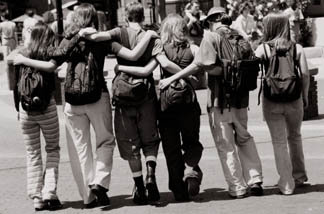|
observer |
|
|
|
|
|
OTHER LINKS |

|

|

|
Adolescence: problems and challenges-2:Engendering blockades of our generationAbout 30% of adolescents did not cite any of the skills they possessed that they disliked. Most prominent problems are the poor academic performance (35%) and lack of job (30%) respectively. A very few were worried about their external appearance (less than 7%) of lack of talent for sports irrespective of gender.
Perceptions affecting mental wellbeingIt is obvious given the prevailing problems in society; non school-going children were tending to have more worries and frustrations adversely affecting their mental wellbeing compared to school-going adolescents. Perception of happiness in generalAlthough half of the out-of-school respondents were of the opinion that they were happy with their lives, about 10% were not happy and perceived their life as not being good across gender. The negative perception about their self-worth was found among the adolescents who had either no education or only primary level education which is steadily declining with a rising of socio-economic status. The adolescents in the higher social and economic status were generally happy with their lives. Experience of DiscriminationDiscrimination generally occurred in relation to race, religion, gender, occupation and many other social divisions. This may lead to protracted conflicts when it occurred among population groups. On the other hand, at an individual level, there may be long-term and short-term repercussions affecting the mental wellbeing and the way the individual deals with society at large. About 21% of out-of-school adolescents expressed that they have been discriminated against, the most common reasons cited were poverty (48%) , followed by poor academic achievement (25%). About 14% felt that they were discriminated against on ethnic and religious grounds. However, there was no gender preference in the proportion of adolescents who reported experiencing discrimination. Tamils reported the highest proportion of discrimination (29%) followed by Moors. Discrimination was higher among those who have never been schooling and with only a primary education. The proportion of discrimination rose with increasing socio-economic level. Key worries citedThe key worries cited were family financial status (28%) and fear of not being able to find a job (25%). A small proportion of adolescents were worried about their relationships with parents (5%) and about not having anyone to care for (3%). There was no difference in sex or ethnicity. Those educated up to secondary level were worried about not being able to study further. About 4% of those who studied up to A/L identified failing to study further as their key worry. The proportion of adolescents who had no worries increases with raising social and economic status. In the North East, the highest proportion of the adolescents worried about being unable to study?. General perception on familyThe general perception on family among the adolescent was a positive one (75%). About one third perceived their families as caring and warm, and another 39% perceived their relationship as good. For 21%, family relationship was average. The perception of males and females were similar with girls more positive about their relationship with the family than boys. The most negative relationship with family was among those who had no education and with no education. Increasing socio-economic status saw a positive relationship pattern. Relationships with the familyA positive relationship was shown among 40%-50%; about 50% of out-of-school adolescents reported they loved to spend time with their families. and 40% were proud of their families. The proportion of negative relationship with family was reported among 10% or less of adolescents. Ten percent were not happy about their relationships with family, 9% were not confident that they could depend on their families, 7% reported that some of their members got on their nerves, 4% felt left out of the family, and 3-4% were shamed of their family. Six per cent felt that their fathers put too many restrictions on them. Selecting a future partnerIt was observed that establishment of intimate relationship for the majority of people commences during adolescence. Apart from biological attractions that influence coupling, factors such as degree of self-awareness, parental pressure, peer influence, social norms, communication skills, have an impact on selecting a future partner. The largest proportion of adolescents (46%) said that they would select their partner on their own, as it was right to do so, while a third (31%) said they would look to their parents' advice on the matter. Five per cent would seek advice from someone they respect other than parents' advice. Seventeen per cent were not sure of their choice yet. However, decision based on solely one's desire to exercise his or her rights cannot be considered as optimal due to the fact that decisions are frequently based on emotions with proper exercise of life skills like empathy , critical thinking and problem solving abilities. Next week:The work cited: 'National Survey on Emerging Issues among adolescents in Sri Lanka' conducted by UNICEF. |
 Among the North and East, higher proportion was reported of those who
expressed that they do not like themselves. However, the proportion of
adolescents who had no regret about themselves increases to the
proportion of increasing social and economic status.
Among the North and East, higher proportion was reported of those who
expressed that they do not like themselves. However, the proportion of
adolescents who had no regret about themselves increases to the
proportion of increasing social and economic status. 







